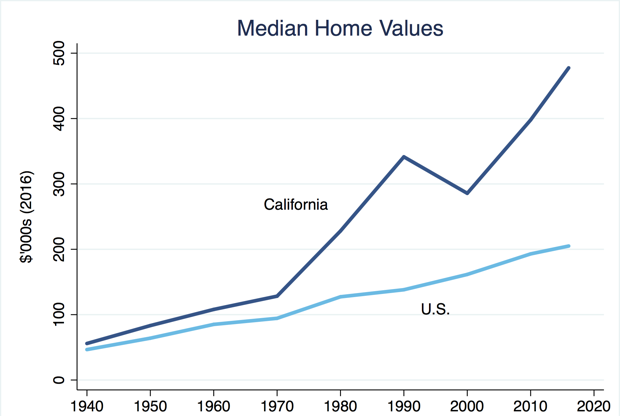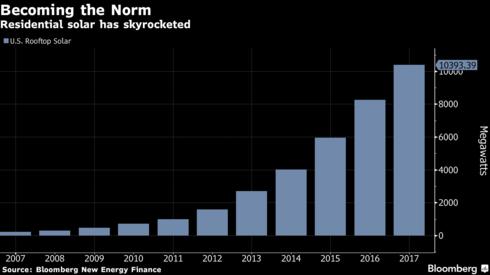California knows it will have difficulty reaching its renewable energy and greenhouse gas reduction goals so it is now mandating that most new homes have solar panels installed during construction. This mandate will increase the price of a home by $8,000 to $12,000, according to the state. That estimate, however, may be low. Contractors in the San Diego area, for example, have put the costs at about $20,000, depending on the size of the home. California median home prices have already been rising faster than the rest of the United States, and this will further exacerbate the state’s housing problems.

According to the California Energy Commission, the rule requires most new homes built after January 1, 2020 to include solar systems. The new policy, which does not need to be approved by the California legislature, applies to single-family houses and multifamily units that are three stories or under. Homes that are shaded by trees or taller buildings, and houses with roofs too small to accommodate a photovoltaic solar system, would be eligible for exceptions or alternatives to the mandate. Under the new requirements, builders can either make individual homes available with solar panels or build a shared solar-power system serving a group of homes. In the case of rooftop panels, they can either be owned outright and rolled into the home price, or made available for lease on a monthly basis.
The new rule will help California reach its renewable portfolio standard, requiring at least 50 percent of the state’s electricity to come from renewable sources by 2030. California has also mandated that it reduce its greenhouse gas emissions by 40 percent from 1990 levels by 2030.
Residential Solar Power
The U.S. had 10.4 gigawatts of residential solar power at the end of 2017—about six times more than the level five years earlier. At the end of 2017, California was the nation’s leader in installed solar capacity, with solar energy providing almost 16 percent of the state’s electricity. With California’s decision to mandate solar panels on most new homes, California will be helping the solar industry, which started slowing in 2017 amid policy changes and efforts by some companies to shift their strategies. In 2017, solar jobs declined 3.8 percent nationally and 14 percent in California due to changes in net metering rules and a maturing market.

Recent changes in Trump Administration policy will cause solar power to become more expensive. In January, President Trump imposed tariffs of up to 30 percent on solar panels made abroad. The solar industry relies on parts made abroad for about 80 percent of its supply. In addition, solar installers have estimated the recently imposed tariffs on imported steel and aluminum can raise the price on the racking system on a home by about $100 to $200, depending on the size of the installation.
California adds about 80,000 new homes a year, of which about 15,000 include solar power. Since the average home solar system uses 2.5 kilowatts to 4 kilowatts of panels, the additional 65,000 new systems would add as much as 260 megawatts of annual demand for panels in the state, which is about the size of one large solar farm. One solar company is expecting the new rule will increase the demand for residential solar in the state by about 50 percent.
The California Energy Commission estimates that the standards will add about $40 to an average monthly payment based on a 30-year mortgage. The rule comes, however, at a time when real estate prices in California are increasing and reaching record highs. For example, the median price for a new home in the San Diego area in March was a record high at $550,000.
Other Solar Initiatives
California is taking a major step with this rule—far greater than other policies benefitting solar power. Prior to this rule, some cities in California have required that certain new buildings include solar power. And, according to the National Conference of State Legislatures, certain other states or cities (New Jersey, Massachusetts and Washington, D.C.) have considered legislation to require that new buildings be solar-ready. Hawaii has mandated other energy-efficiency measures, such as solar water heaters.
Issues with the Rule
California’s ramp-up in solar power production is already causing its grid operator reliability issues due to solar power’s intermittent availability. The state has so much solar power that it has had to pay neighboring states to take the excess electricity to avoid overloading its power lines. This rule will only exacerbate that problem. And, California already has a shortage of housing. Adding thousands of dollars to the cost of a home will only make the shortage problem greater. And, lastly, California is instituting a policy that is picking winners, which should be a market-driven, feasibility-driven decision by home owners. History has shown that governments do not have a good track record for picking winners. Favoring one technology over another is not a prudent way for California to reach its self-imposed renewable and greenhouse gas mandates.
Conclusion
California is again at the forefront of renewable energy policy, requiring most new homes to have solar panels installed during construction, which will add about one large solar farm a year. The California Energy Commission hopes that this policy will help achieve the state’s requirement for 50 percent renewable electricity by 2030. But the rule will exacerbate California’s housing shortage, its reliability issues with solar power, and the state will be picking winners, favoring one technology over others.